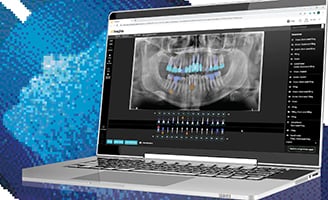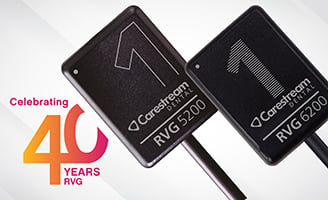Implants and CBCT
It is no longer a debatable fact that three-dimensional imaging is the standard of care when it comes to the surgical component of implant placement.1 The key here is to understand the value of achieving the three-dimensional view, simply phrased as the depth component of the visual anatomy. CBCT images are valuable to understand the topography and—more importantly—the inner component of the osseous structures.
Although all the image stacks are very critical to forming an opinion of the anatomical region in consideration, it is the cross-sectional view that is the most used when it comes to virtual planning of implants. Surgeons are better able to appreciate the buccal-lingual dimension of the bone when viewing the cross-sectional reconstruction of the scanned anatomical area of the jaws. While viewing this reconstruction and other multiplanar images, there are some key anatomical markers to be evaluated as a part of the visual assessment of the bone.
It is expected that the morphology of the edentulous areas varies not only between individuals but in an individual’s oral cavity. Age is a critical factor in the change noted in the osseous structures. Another critical factor is time; the longer a patient stays edentulous, the more the probability of resorption of the alveolar crest. This leads one to note the following three (not limited to) critical changes in the jaws:

- Lingual undercut: Lingual undercuts of varying degree are noted in most individuals. As much as this is an anatomical variation, it becomes an area that gathers the attention of the clinician while performing the surgical component of placing an implant. Accommodating a lingual undercut is critical to avoid perforation of the cortical plates.
- Knife edge ridges: These mostly occur in areas that have stayed edentulous for a fairly long time. They are also more prominent in the anterior areas of the ridge due to the reduced bone in these areas coupled with anatomical variations in the localized region.
- Ridge angulation: Severe ridge angulation can result in compromising the placement of the implant by itself which could further lead to lack of stability when the masticatory and occlusal forces are in play. Noting the ridge angulation and making the right choice of the implant to compensate for the angulation is of utmost importance, mainly in the load bearing areas being treated for edentulism.
Lack of cortical bone structure could possibly indicate a generalized Osteopenia, whereas lack of trabecula in the cancellous bone structure could indicate generalized Osteoporosis of the individual. These vary by age and gender of the patient. These changes have a predisposition among females of post-menopausal age groups. Osteoarthritic changes can be age related and noted among a broad spectrum of middle-aged individuals to seniors.
1. Tyndall D. A., Price J. B., Tetradis S., Ganz S. D., Hildebolt C., Scarfe W. C. Position statement of the American Academy of Oral and Maxillofacial Radiology on selection criteria for the use of radiology in dental implantology with emphasis on cone beam computed tomography. Oral Surgery, Oral Medicine, Oral Pathology and Oral Radiology. 2012;113(6):817–826. doi: 10.1016/j.oooo.2012.03.005.






